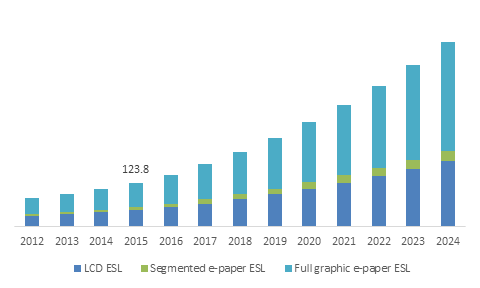Electronic shelf label (ESL) market to depict a double-digit growth rate over 2018-2024, commercial applications to augment the industry expansion
Publisher : Fractovia | Published Date : 2018-09-27Request Sample
The importance of depicting product prices and information has soared considerably in recent times, augmenting electronic shelf label (ESL) market trends. The technology not only helps retail personnel but also offers ease of shopping to customers pertaining to its capability to manage and control the stock in store. Nowadays, considering the sophisticated use of this technology, retail magnates have been adopting the same on a large scale, given that it has been helping retailers reduce manual errors and inaccuracies. In addition, owing to its excellent reliability, speed, and cost pricing management, the ESL system has become rather popular among numerous industrial and commercial end-users. The increasing popularity of ESL systems for improving pricing accuracy and stock management is thus likely to enhance electronic shelf label industry share.
Germany ESL market size, by product, 2017 & 2024 (USD Million)

In the last few years, with changing consumer shopping preferences, retail companies have forced themselves to modify their approach toward business. In line with the changing consumer lifestyles, the onset of market chains such as hypermarkets and supermarkets have become a tall order. Having emerged amidst a supremely competitive e-commerce marketplace, most of the hypermarket and supermarket are deploying ESL systems to attract more consumers. As of now, many hypermarkets and supermarkets are implementing ESL systems in their workflow on a large scale to enhance their business which will have considerable impact on electronic shelf label market size. Some of the instances validating the surging use of digital tags influencing the product demand have been described below.
In this era of digitalization, myriad industries have been enlisting the help of technologies to transform business models. For instance, one of the German hypermarket chains, Kaufland, recently decided to deploy a self-service technology in order to transform its store. With the implementation of such an advanced technology, it is looking forward to improving shopping experience, increase customer loyalty, and decrease waiting times. As of now, it has equipped nearly 160 stores with the self-checkout solution and is planning to expand this technology across other European countries over the years ahead.
Reportedly, Kaufland operates more than 1200 grocery stores across multiple European countries comprising Romania, Croatia, Czech Republic, Poland, Bulgaria, and Slovakia. In addition, this German grocery chain has been working constantly to massively adopt electronic shelf label systems which will help the firm expand business by attracting more customers and improving its existing customer base.
The advent of new technologies and automated ESL systems have imprinted a considerable influence on the business approach of retail giants and grocers. The development of Near Field Communication (NFC) technology is one of the breakthroughs that has transformed the approach of retailers as well as customers toward shopping. With the help of NFC-enabled electronic shelf labels, retailers can share more data and additional information with the customers who can access that information with the help of their NFC-enabled smartphones. In this regard, the surging adoption of smartphones across the globe will favorably promote the use of NFC technology in electronic shelf label (ESL) market.
Considering the effectiveness of NFC technology on the overall business scenario, many supermarkets have found to have adopted this technology – the world’s largest retailer and French supermarket giant, Carrefour, and the Swedish supermarket, ICA Nära Norrviken, can be quoted as valid instances in this context. In 2015, ICA Nära Norrviken had used NFC tags to educate the customers about its promotional deals, competitions, discounts, and detailed product information. It also had deployed NFC smart posters outside the stores to allow customers to buy packaged grocery bags from their smartphones directly. Carrefour, in 2014, had also decided to equip its hypermarket with nearly 55,000 NFC shelf-edge labels that could help consumers to interact with products. The deployment of NFC technology at these hypermarkets have also been proving to be rather beneficial for shoppers to make payments at POS terminals.
All-in-all, in order to give rise to strategic business opportunities in this era of e-commerce, most of the retailers have been adopting ESL systems which will propel electronic shelf label industry size. The advent of new wireless technologies and continuous advancement in mobile devices and payment facilities will have a favorable influence on the product demand over the years ahead as well. For the record, in accordance with the growing retailers’ business chain, electronic shelf label (ESL) market is likely to establish its name in the much-coveted billion-dollar business vertical by the end of 2024.